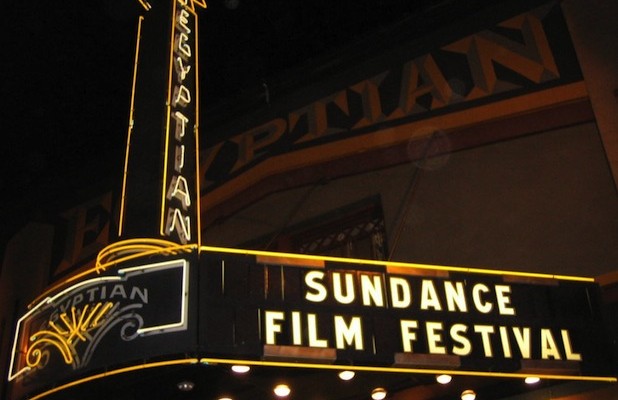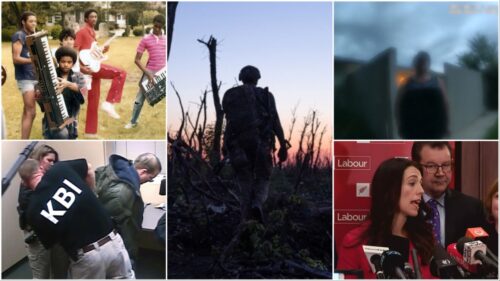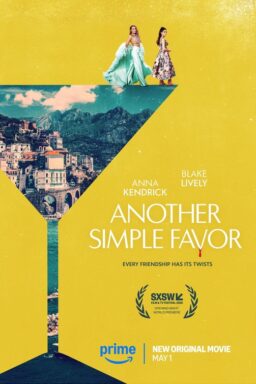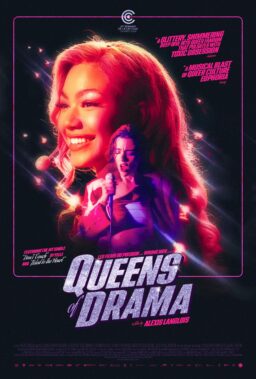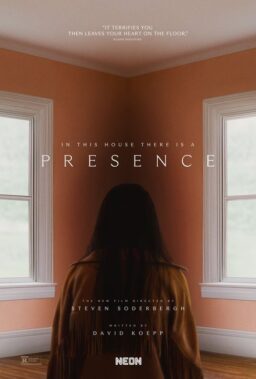Our staff and contributors who
attended this year’s Sundance Film Festival reflect on the event in a series of
emails—Brian Tallerico, Sam Fragoso, Erik Childress, Nick Allen and Patrick
McGavin. Read all of this year’s coverage, film by film, here.
BRIAN: Being the over-working
completist that I am, I often come out of festivals like Sundance lamenting
what I missed as much as praising what I saw. So, while I got to 36 films this
year (and had seen 2 more at TIFF), I regret not having hit Sean Baker’s
“Tangerine,” Matt Sobel’s “Take Me to the River,” Craig
Zobel’s “Z For Zachariah,” Kirby Dick’s “The Hunting
Ground,” Alex Gibney’s “Going Clear,” Patrick Brice’s “The
Overnight,” and Marielle Heller’s “The Diary of a Teenage Girl.”
The fact is that it’s impossible to hit everything. I had a great Sundance in
2014 and missed “Love is Strange,” “Obvious Child,” and
“The One I Love,” among others. So, one thing that interests me as we
get this conversation going is this–other than assignments from your editor,
how do you choose what to see at a fest like Sundance? And do you think you made
the right choices this year?
SAM: Thankfully, I did have an
“over-working” editor guiding me this year—telling me what I needed
to see, and what I could see. In years past my process is fairly simple: First,
choose the films by directors I’m familiar with. Second, put an asterisk next
to films that sound interesting. Third, stay away from movies that have already
premiered at other festivals. At least for coverage purposes, you’re not going
to get a lot out of “Eden” or “Wild Tales,” no matter how great
they’re are (note: they are both amazing). Fourth, don’t worry about missing
any movie that already has distribution. “The End of the Tour,”
“Mistress America,” and “True Story” are good examples
of larger films that will doubtlessly play at a theater near
you soon enough. Lastly, leave room in your schedule for movies that
unexpectedly gain buzz during the festival. There are always a handful of
pictures that become favorites All that said, I’m still convinced I never see
enough movies — or the right movies. This year I left Park
City without seeing “Brooklyn,” “Me, Earl, and The Dying
Girl,” and “The Witch.” I’ll live, hopefully.

ERIK:I tend to read the descriptions of the films
first as I begin the first of 11 phases of planning my schedule. Go through the
entire list, note what sounds intriguing, then go over it a second time to see
which filmmakers I recognize. Those I do get asterisk number two. Those I
may have been burned with at a festival in the past lose one. Then I keep an
eye on the casts. Who are the leads? Is it a good ensemble? Favorites always
come into play when you have to narrow down a list to roughly 20% of the entire
festival schedule.
For many years I would
tend to stick to my original schedule through hell and high water. I’ve learned
over time how to read buzz at a festival and recently that has helped adjust my
schedule on the ground. Normally at Sundance if you miss something everyone is
raving about, you do not get a chance to catch up with it unless there is still
a public screening you can get a ticket to or the fest schedules a second press
screening. But if you hear a lot of negatives from voices you trust and respect
and there is another option in that impending timeslot, I could go sight unseen
into something else and maybe THAT becomes the next can’t-miss film. I was one
of the many locked out of the initial showing of “The Witch” and I’m
sorry that I missed “The End of the Tour” and “Brooklyn,”
but it only increases my excitement for their eventual release.
NICK: Before my first Sundance this year, I was lucky enough
have experienced the festival craziness of South by Southwest in 2011 and 2012.
I took away from those ventures the importance of discovery; you’ve got to hit
film festivals like these with your pioneer cap on. When you’re a filmgoer like
me who wishes they could go into every new film knowing only a title, Sundance
is giddy terrain of hunches, fuzzy insider buzz, and even straight-up incorrect
projections. Nothing aside from “Me & Earl & The Dying Girl” was
pitched like an absolute guarantee, and even then I did not feel love for that
soon-to-be indie monument.
To provide some order to a chaotic schedule, I did have
my must-sees. I wasn’t going to fly to Utah, chug along on a frighteningly
small amount of sleep, and miss the unveiling of unseen films like Jared Hess’
“Don Verdean,” or the Neil Hamburger experimental project “Entertainment” (both
of which I am glad I didn’t miss.) And a few other titles provided shape, such
as “Knock Knock” and “Sleeping with Other People.” But a good amount of titles
came into my life through a day-by-day perspective. In an environment where
three movies a day feels like a disappointment, but a three-hour nap feels like
a life-and-death sacrifice, you really do have to accept that seeing everything
is impossible within a certain festival-going window. I found that it was best
to throw your schedule into the fateful winds of convenience, regarding the
titles that are screening closest together in both geographical and time
terms.
So, like Erik, I too will wait a bit longer to witness
“The End of the Tour, “Brooklyn,” and “The Witch.” But at the same time, by
steering myself mostly by proximity, I experienced documentaries like “Listen
to Me Marlon” and “Pervert Park.” Those two discoveries only happened because I
didn’t strictly stick to a movie-going map.
PATRICK: This was my 24th Sundance. Some of those years
I worked as a reviewer for the trades, and I had very specific assignments.
This year, I had a couple of very concrete gigs I had to satisfy, but otherwise
I was free to roam. All festivals have their own rhythm and rituals, and as the
first significant festival of the year, Sundance often sets a particular tone
or sense of expectation.
I have an inverted
pyramid format I adopt, privileging the dramatic competition titles (this year
I saw 13 of the 16 titles) and then pursuing, in order of importance: Next, the
premieres, documentaries and the occasional Spotlight title I missed elsewhere.
Structurally the festival is different than the others I cover. At most
festivals, a film will play two or three times within a very specific time
frame. At Cannes, Venice or Berlin, for instance, the accredited press
primarily sees the same film at the same time and opinion coalesces around a film
very quickly. At Sundance, the dramatic competition titles or the documentary
competition titles play five or six times over the duration of the festival,
and point of view or word of mouth works very differently.
You can’t satisfy
everything, and I regret not seeing more of the world cinema competition or the
Frontier titles. At some level all festivals are an abject lesson in failure
and disappointment, because it is impossible to see all the things you want.
Also, Sundance is not a vacuum or an isolated event, it’s the first stage of a
year-long odyssey, the way I look at it. The movies I missed are now part of my
consciousness in a way they maybe weren’t two weeks ago. And I already know the
titles I want to see again or those I need to track down.

BRIAN: Were there any themes that seemed particularly
resonant across multiple films this year? It’s tempting to say that the theme
of Sundance 2015 is that there is no theme of Sundance 2015. I mean,
competition films like “Dope” and “The Witch” couldn’t have
less in common, and I liked that diversity in terms of selection this year. I
saw a wide variety of filmmaking styles, protagonists, genres, periods, etc.
The only that stands out at all across a few of my favorite films might be how
we see ourselves through the prism of pop culture. The kids in
“Dope,” Greg & Earl in “Me and Earl…,” even the way
the Davids (Lipsky & Foster Wallace) respond to fame and journalism in
“The End of the Tour.” As pop culture becomes even more intrinsically
rooted in how we communicate with each other, this is a theme that I expect
will become even more prominent in film. What did you see thematically this
year that struck a chord?
ERIK: While it would be easy to jump on the standard
theme of “how we deal with impending death” as seen in “James
White” and “Me and Earl and the Dying Girl”, there was a far
more intriguing one that dealt more with how we live. Particularly men. For a
long time we have heard of the underlying “fear of women” that can
manifest itself mentally to as far as economically. The distance that males
project from the fairer sex was on ample display in films at Sundance this
year. In the aforementioned “Me and Earl and the Dying Girl” the lead
character is forced into a friendship with the titular dying girl by his mother
and while he insists through narration that the story is not a romantic one, it
may just be a denial that also prevents him from asking out the school beauty
despite her frequent attention. All part of the closed-off path he has chosen
for himself in high school. To show how far the bond (or frequent lack thereof)
between men and women, the western “Slow West” is built upon the
young protagonist reading far more into the friendship with the girl he is
trying to rescue than she ever did. Flash forward to the future where “Z
for Zachariah” goes from a one-woman tale of apocalyptic survival into a
power play of which second-to-last man on Earth is going to bed her down; each
careful to keep their distance just enough to not frighten her away.
“Sleeping with
Other People” takes the more traditional “When Harry Met Sally”
approach to old friends who are not ready to admit they have feelings for the
right person in their lives. But then there was “Results” which is
patterned around a triangle of three characters who are never quite sure what
they want out of one another. Kevin Corrigan’s new millionaire is not a bad guy
but takes a physical fascination with Cobie Smulders’ fitness trainer who is
too wrapped up in her routine to consider anyone beyond momentary pleasure. Yet
it is her that must assert herself into the life of her boss (Guy Pierce) for
him to believe there is the potential of a future with her. “Mississippi
Grind” features two characters unsure of how to react to women who clearly
want their company. Ben Mendelsohn’s Gerry may have an alternative view of
Analeigh Tipton’s call girl but he never follows through on the assumed baser
instincts. Likewise Ryan Reynolds is indecisive of mapping out a life with
escort Sienna Miller who has more of a financial than romantic stake in their
relationship.
Then there was also the
unfortunate flipside that could be led by Eli Roth’s “Knock Knock”
which sees family man Keanu Reeves desperately trying to keep his urges in
check when two young nubile females show up to his home during a rainstorm. As
they are the aggressors in the situation, it is hard for him to resist the
“free pizza” forever. Just as Patrick Wilson’s attorney samples every
flavor of an escort agency in “Zipper” and Alexander Skarsgård can’t
keep his girlfriend’s 15 year-old daughter from coming onto him in “The
Diary of a Teenage Girl.” Further appalling behavior could be seen in
“The Tribe” and Kirby Dick’s doc “The Hunting Ground” when
men react violently against the non-reciprocation of their desires. Almost
makes the porn at the center of the documentary “Hot Girls Wanted”
feel like a healthy alternative by keeping the male fantasy at a necessary
distance. Makes one wonder if the overall theme of Sundance was actually that
men also have feelings and women have needs too.

NICK: To add onto what Erik has said, there seems to
be an unofficial centerpiece to these expressed notions in Sundance’s
programming of the documentary of “The Mask You Live In.” That film
diagnosed many of the ideas about physical and sexual aggression and emotional
regression within males in particular. Director Jennifer Siebel Newsom’s
documentary (executive produced by six women, and co-written by a woman) boiled
it down to an unachievable masculinity, in which from a young age men are
raised on these standards of power that comes from “being a man,”
which nonetheless creates these tough exteriors housing scarred insecurities
throughout the rest of their lives. Perhaps too perfectly, J.K. Simmons’ first
emasculating tirade from last year’s machismo hit at Sundance
“Whiplash” was included amongst “The Mask You Live In’s”
many pop culture visual footnotes.
Though the
documentary’s form was often too preachy and filled with a thousand fades to
white to outright recommend, its initial message sounded off an alarm the way
that Steve James’ “The Interrupters” did about the disease of
violence: if we can stop coaching these ridiculous notions of masculinity that
also see femininity as second-level in comparison, the world wouldn’t be
overflowing with the men explored in these various films, who hurt others and
themselves when wrapped up in these fantastical notions of emotional fortitude
and superiority. Because of these ideas, a lot of these men that you’ve mentioned
in these films don’t know exactly how to open themselves up, (like Greg in
“Me & Earl & The Dying Girl,” or Gerry in “Mississippi
Grind”), or they don’t know how to treat women (as in “Zipper”),
or outright have an active disrespect for women (the basis of “The Hunting
Ground”). Even “Z for Zachariah” turns a single female’s
existence in a post-apocalypse into a type of clash of masculinities, where
what’s at stake most of all is power, and the woman in the love triangle.
Newsom’s film argues that this is destructive programming that is passed on
from older generations to the next, and certainly not something inherent within
how males are different than females. (Frida and Lasse Barkfors’ award-winning
doc “Pervert Park” also makes necessary note of the harmfulness of
the cycle, expressing mental illness about sexuality as often a trait of an
abusive family history, and one that often starts at a young age.)
[“Pervert Park” was screened for press right before “The Mask
You Live In.”])
As Newsom’s film argues,
and I agree too, the current sad state of men’s relationship with themselves
(just watch the final act brawl during this year’s Super Bowl, and then the
Always “Like a Girl” ad) as dealt with by the rest of the world
(women) would be better off if toughness was treated more as a myth than an
attainable ranking. The festival’s discussion of this notion is proof for me,
more than introducing new filmmakers, that Sundance is committed to the
progression of cinema. Buzzy films will come and go, but the ideas within them
can make the most resonant impressions, while influencing a different,
progressively healthier perspective for modern media.
PATRICK: Sundance is always about the primacy of youth,
especially the dramatic competition where the films are primarily
representative of a first or second feature. What I noticed was the film
equivalent of a literary conceit, the Bildungsroman, a novel that tracks the
education, development and emerging sensibility of a young protagonist. It
definitely fits the emotional architecture of “Dope,” “Me and
Earl and the Dying Girl,” “Diary of a Teenage Girl,”
“Brooklyn,” and a few other movies.
“Diary” was
a pretty polarizing title, but I really liked it, in part because of how it
trafficked in a kind of amorality and nonjudgmental attitudes about young
female sexual desire that I’ve always identified with a certain kind of French
say, the “single girl” trilogy by Benoit Jacquot some two decades
ago. That actress Bel Powley was remarkable, and probably because a woman made
it, the movie never felt exploitative. It was audacious, bracing and
unexpected, which is what you want in the movies. One of the problems I had
with “Dope” is, by contrast, the women are fetishized and denied any
real personalities, pure male fantasy figures, reflected in their behavior and
actions and how they relate to the lead characters.
With “Earl,”
I interviewed the director, Alfonso Gomez-Rejon, and I think it’s pretty
obvious from the nature of my questions that I liked a film a lot. I liked the
discrete, off-handed ways it deals with very serious issues, and how it played
with the very ideas of the form, in this case, the high school movie. The movie
starts out almost identically to “The Spectacular Now,” a slow pan
inside a room to a young man sitting before his computer, and telling us of a
story that’s about to unfold. As a scenario, the movie sounds unwatchable; of
course, we know better, and what carries it aloft are the sensitivity and power
of the direction and the actors. The fact is moves so expressively through very
different emotional registers, from euphoria to an unbelievable sadness
illustrates the emotional believability of the characters, the subtlety of
characterization and what the leads and supporting players bring to their parts.
Also, how interesting
that the two big winners, in the dramatic and documentary sections with
“The Wolfpack,” celebrate a very particular kind of cinephilia.

SAM: Certainly
a conversation with Cooper and Groth would be useful here. It’s damn near
impossible to know what films they rejected, and why. I do think Sundance, like
many festivals, is inching closer and closer to becoming mainstream. Every year
the festival picks a whole host of movies that are clearly there to bring in
recognizable faces. TIFF does this plenty, too. But I think if Sundance wishes
to continue labeling itself the King of Independent cinema, they should be a
bit more judicious in their selections. Ardent festival goers will still make
their way to Park City if James Franco isn’t in a movie; Main St. may just not
be as popular.
PATRICK: The great paradox (and beauty, I think) of
festivals is they exist very much in the present, the immediate, but they
require time and space to adequately capture and assess. Sundance cuts between
two paths, the market and acquisition side as the deals are examined and the
eventual box office weighed. The second and to my mind far more interesting
aspect is assessing the artistic merit of this year’s festival. That takes time
(and effort), because even if you’re saw 35-40 movies, that’s roughly a third
of the program.
Last year, my impression at the time was the
dramatic competition, outside of “Whiplash,” and “Kumiko, the
Treasure Hunter,” was fairly weak. The other programs, especially Next,
with “Listen Up Philip,” “Land Ho,” “Girl Walks Home
Alone at Night,” “Obvious Child,” “Inappropriate
Behavior,” was quite strong. Of course, any festival that premieres
“Boyhood,” the film of the year (probably the decade), is going to
look strong in retrospect.
I suspect a year from
now, we’ll look back at say, the dramatic competition was the strongest in the
last two or three years, Next was done by comparison though still interesting,
the premieres had nothing at the level of “Boyhood,” but some highly
idiosyncratic and impressive work, like the Ponsoldt, the Almereyda and the
Boden/Fleck movies.
I didn’t see enough of
the documentaries to make a definitive declaration, though I will say, based on
what I did see, I agree a lot with Anthony Kaufman’s piece in indieWire the
festival has to open up its programming to a more experimental vein and not
just the standard, social issue-oriented, television broadcast format that
dominates the documentary competition.
The final issue, which
I think is a significant one, is that certain movies might be turning up at
Berlin, SXSW, Cannes even, that were turned down by the festival. I think John
Cooper and Trevor Groth are much more transparent than the previous director in
the selection process. For the record, I was talking with a producer whose film
was in Next, and he felt the festival “got it right,” not just with
his film, but the balance of the programming.
